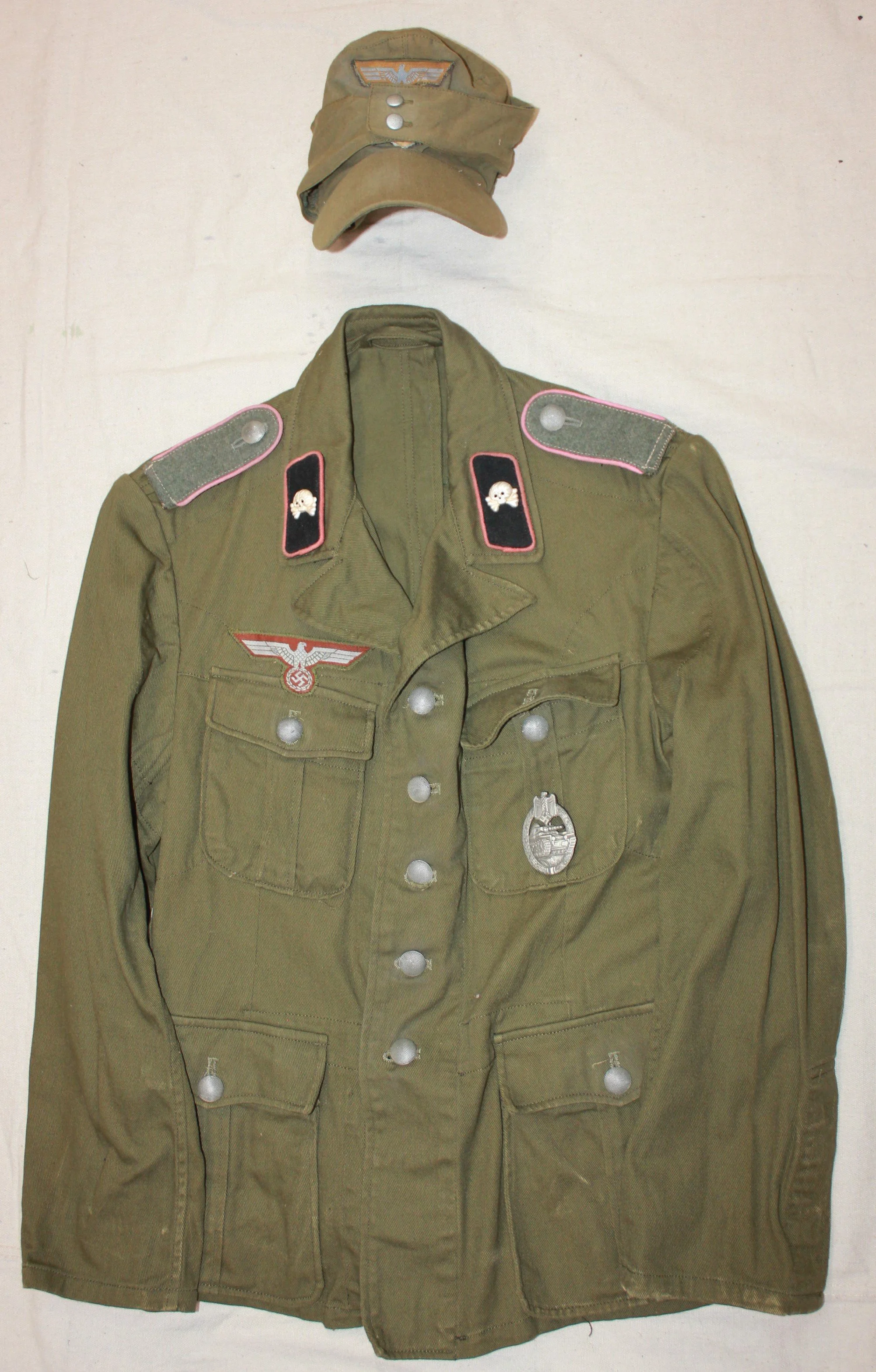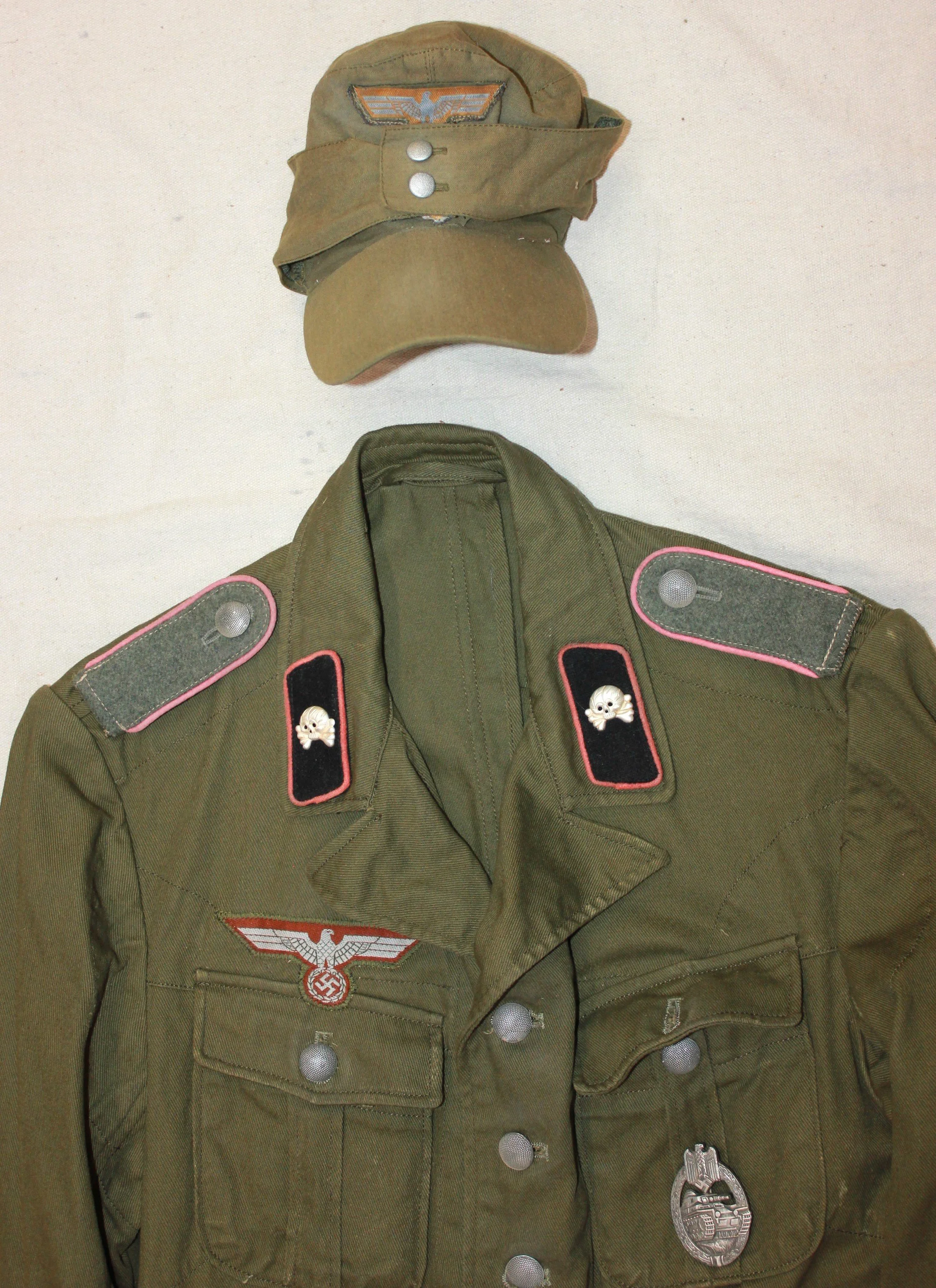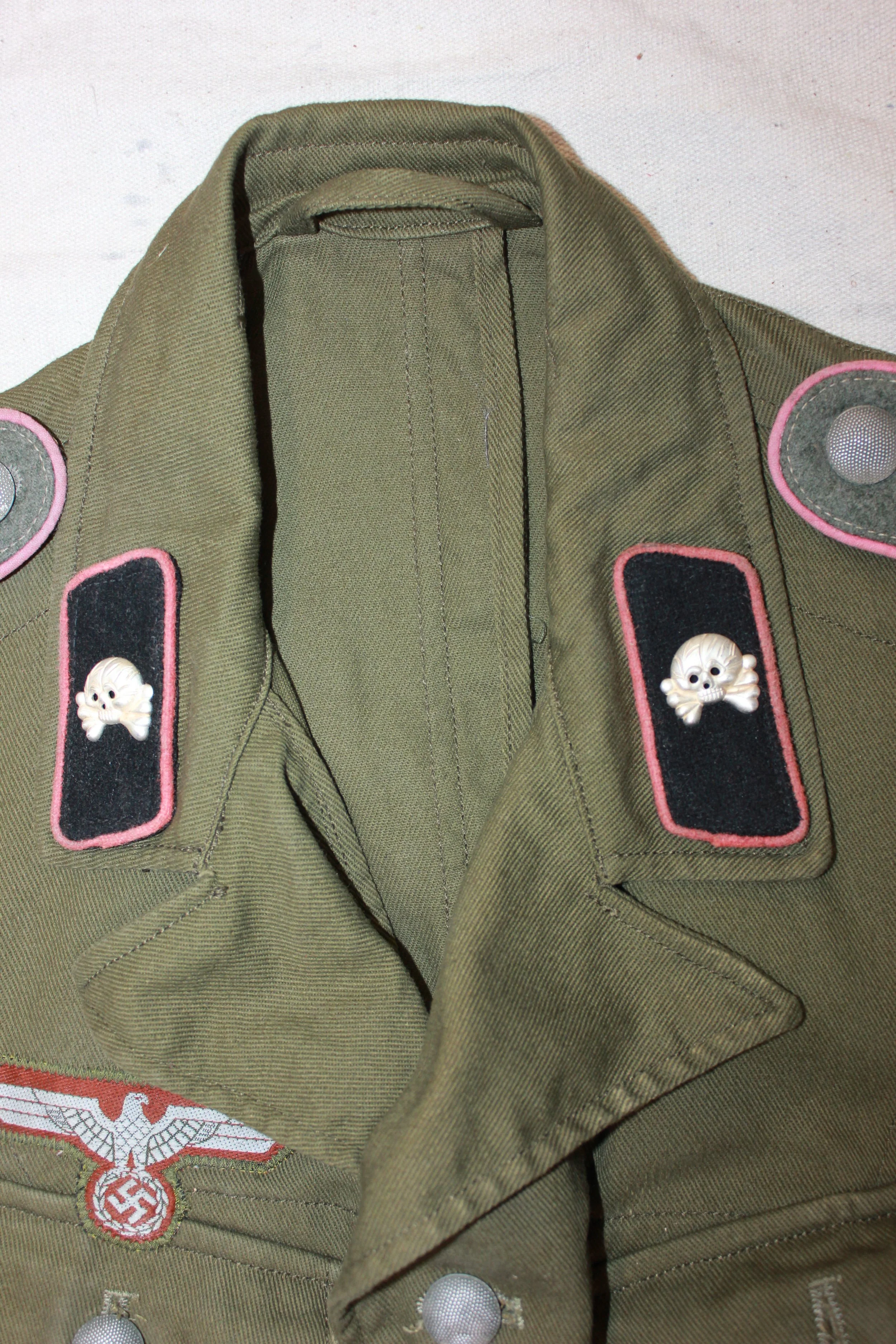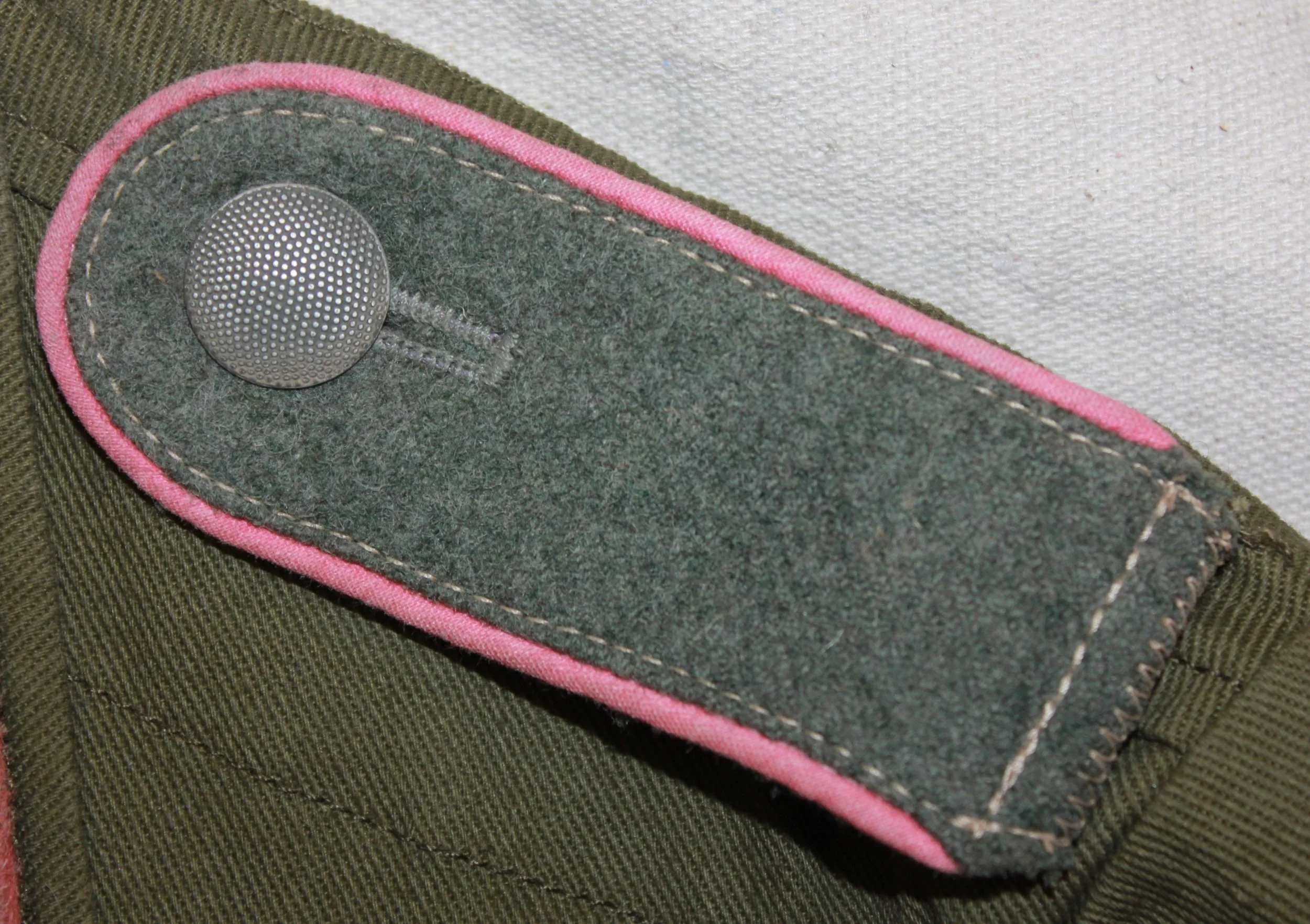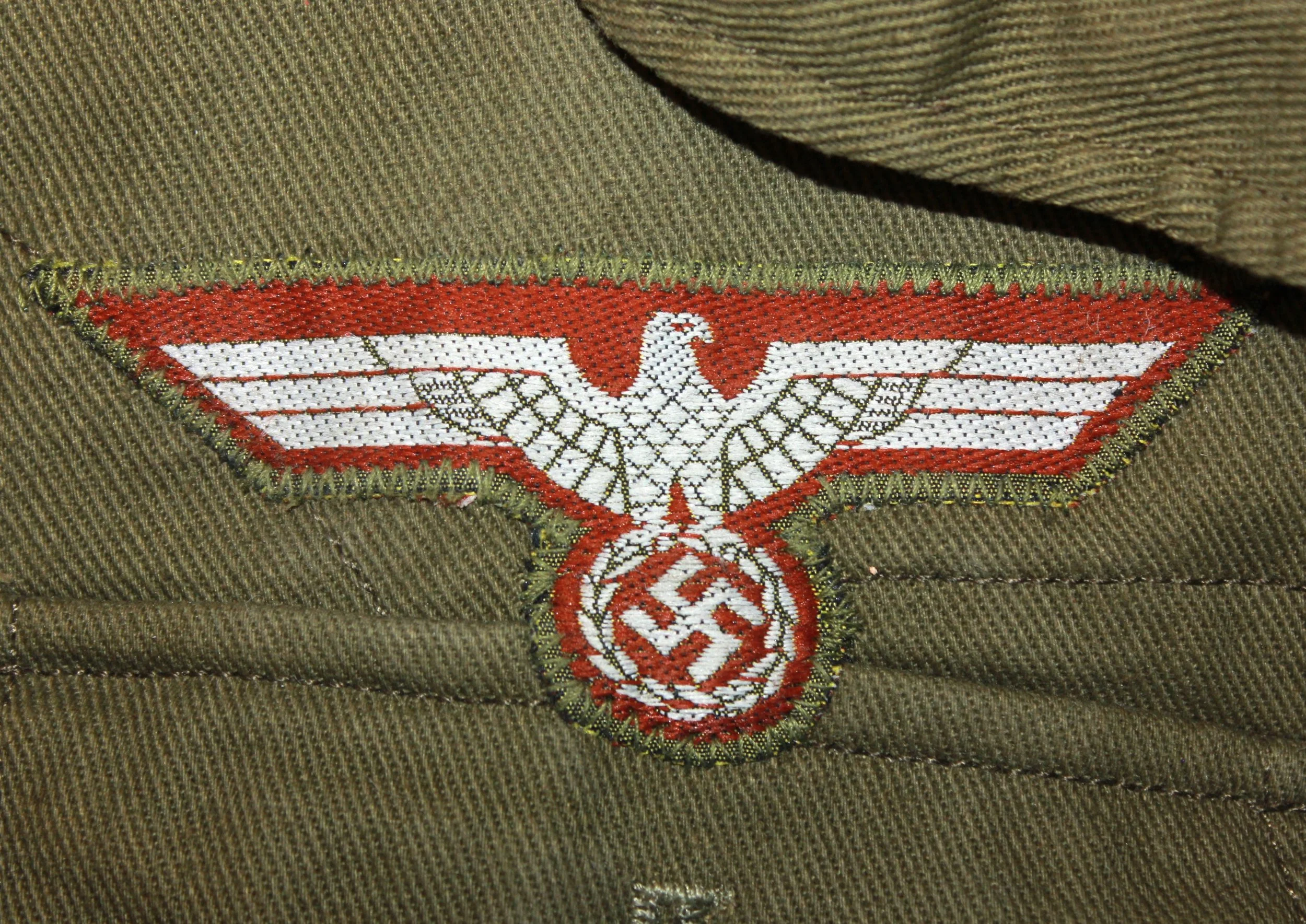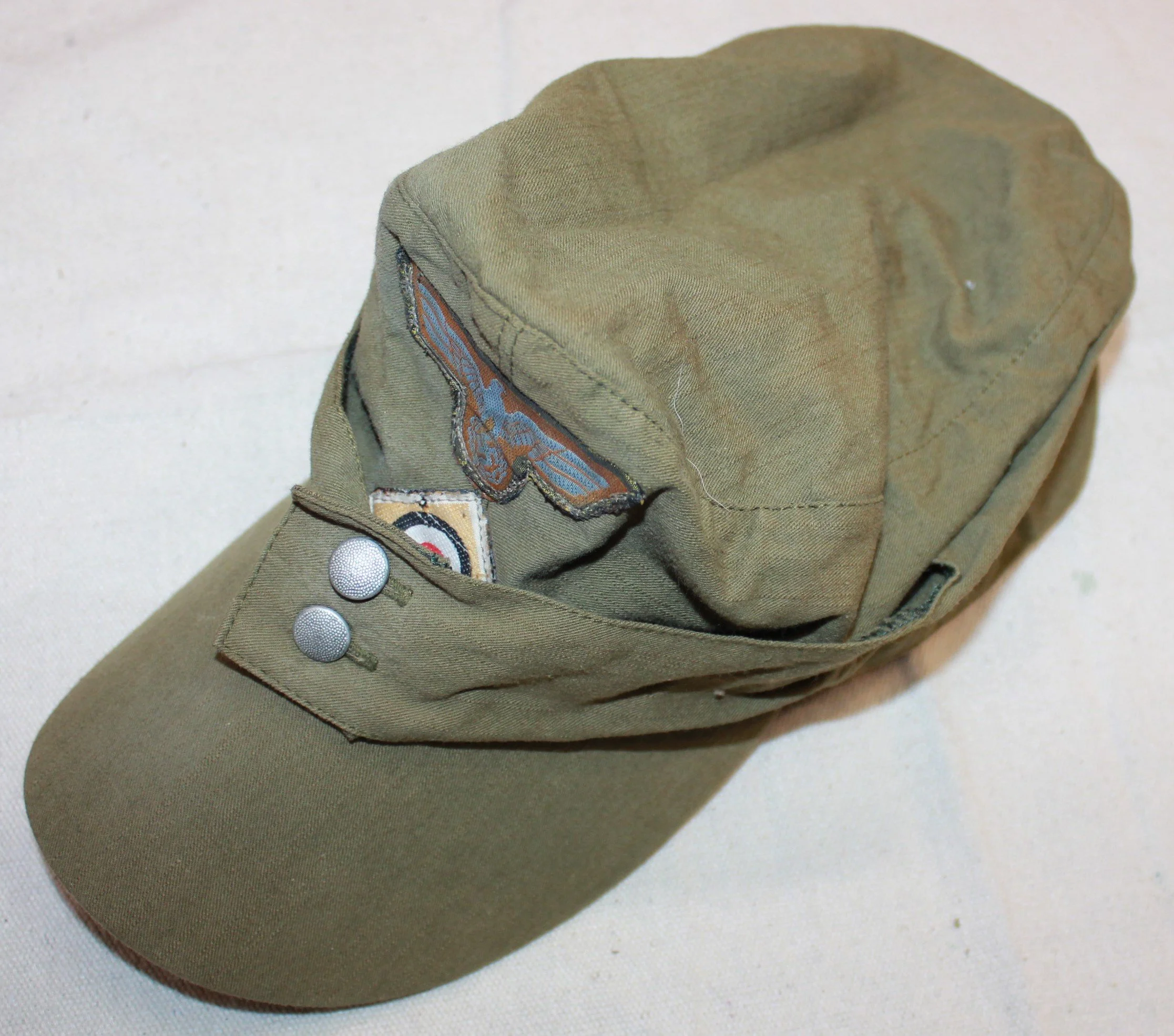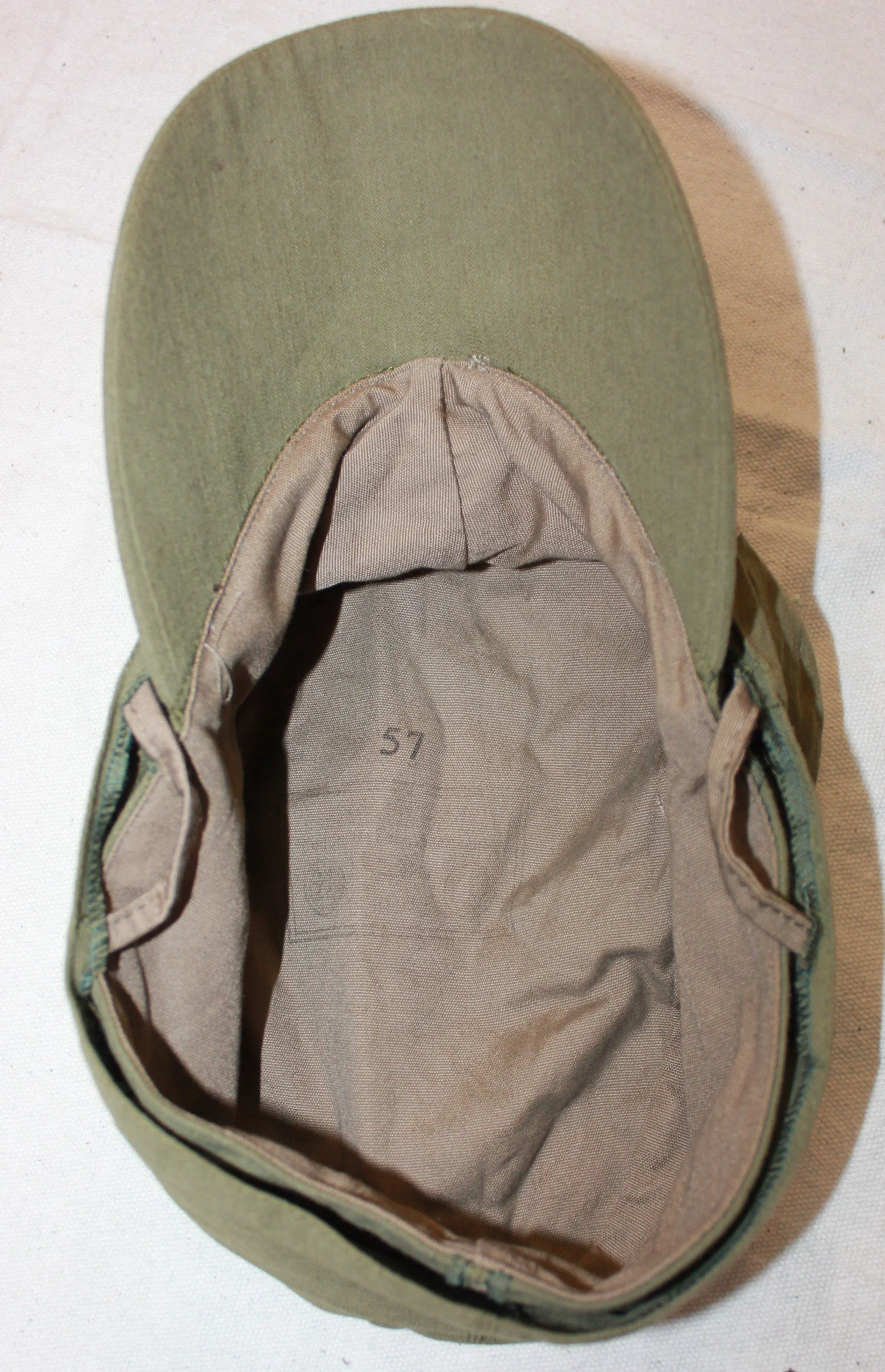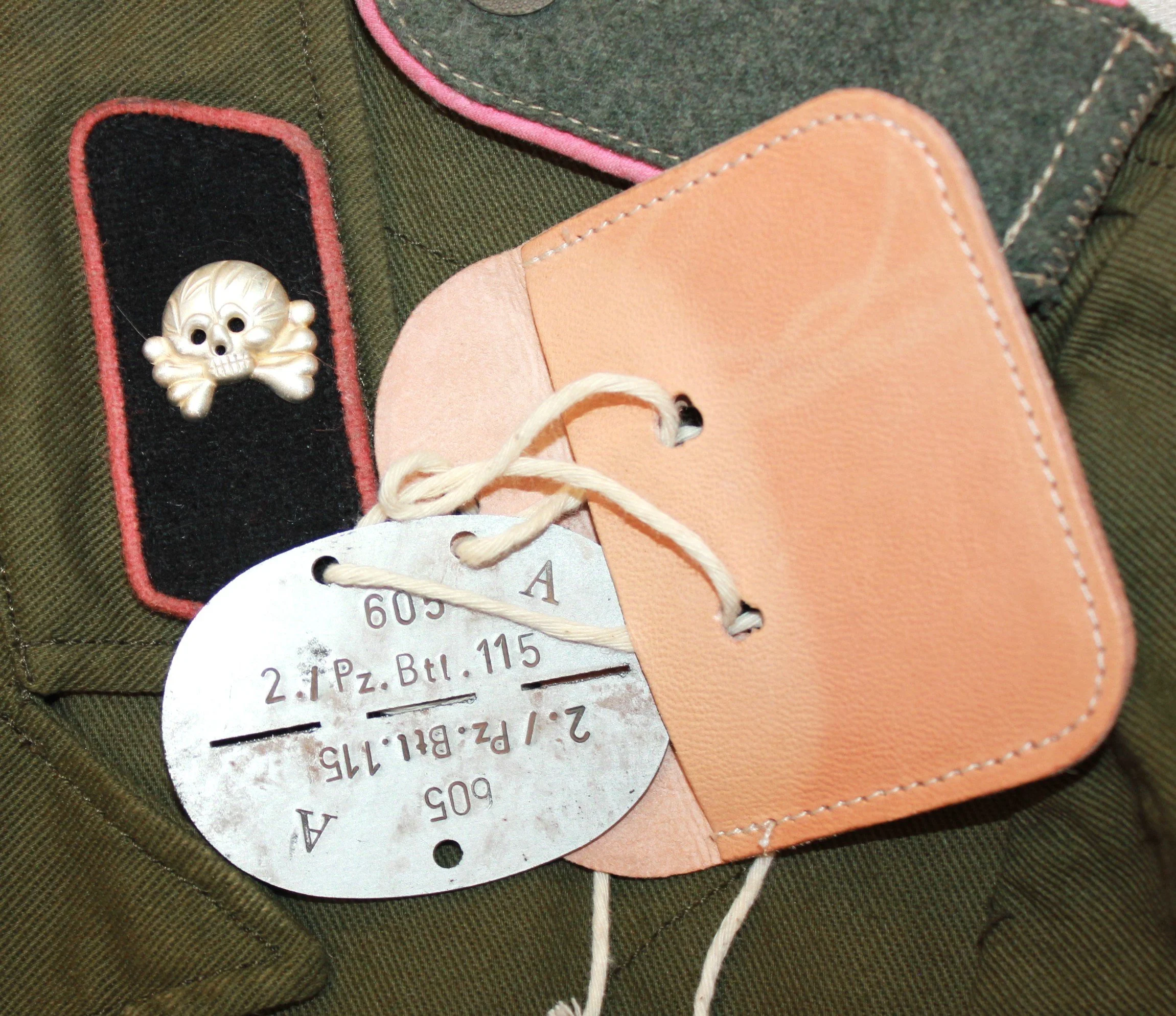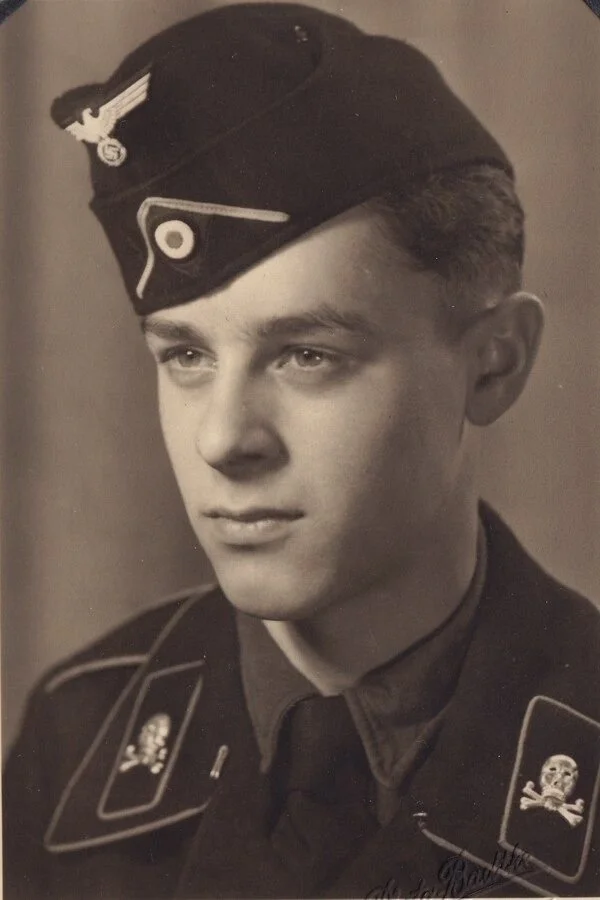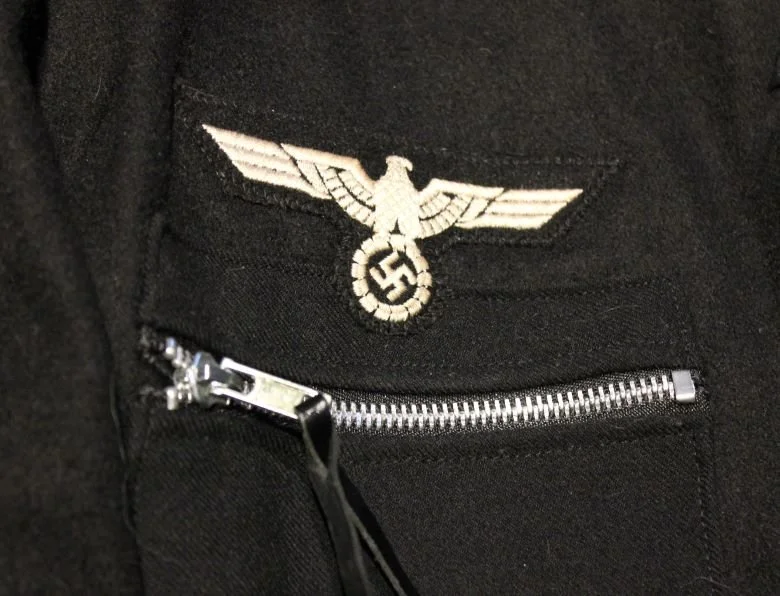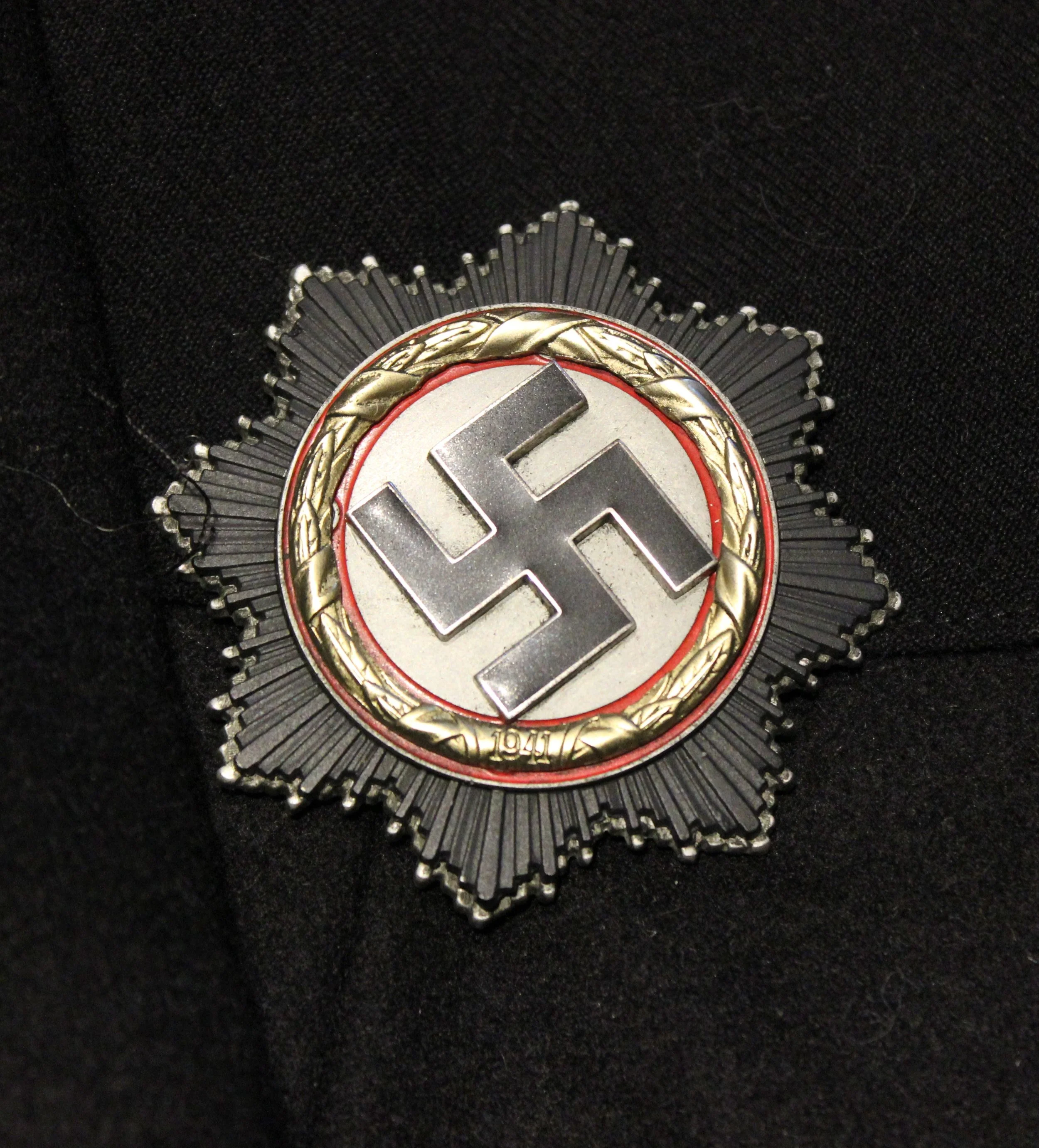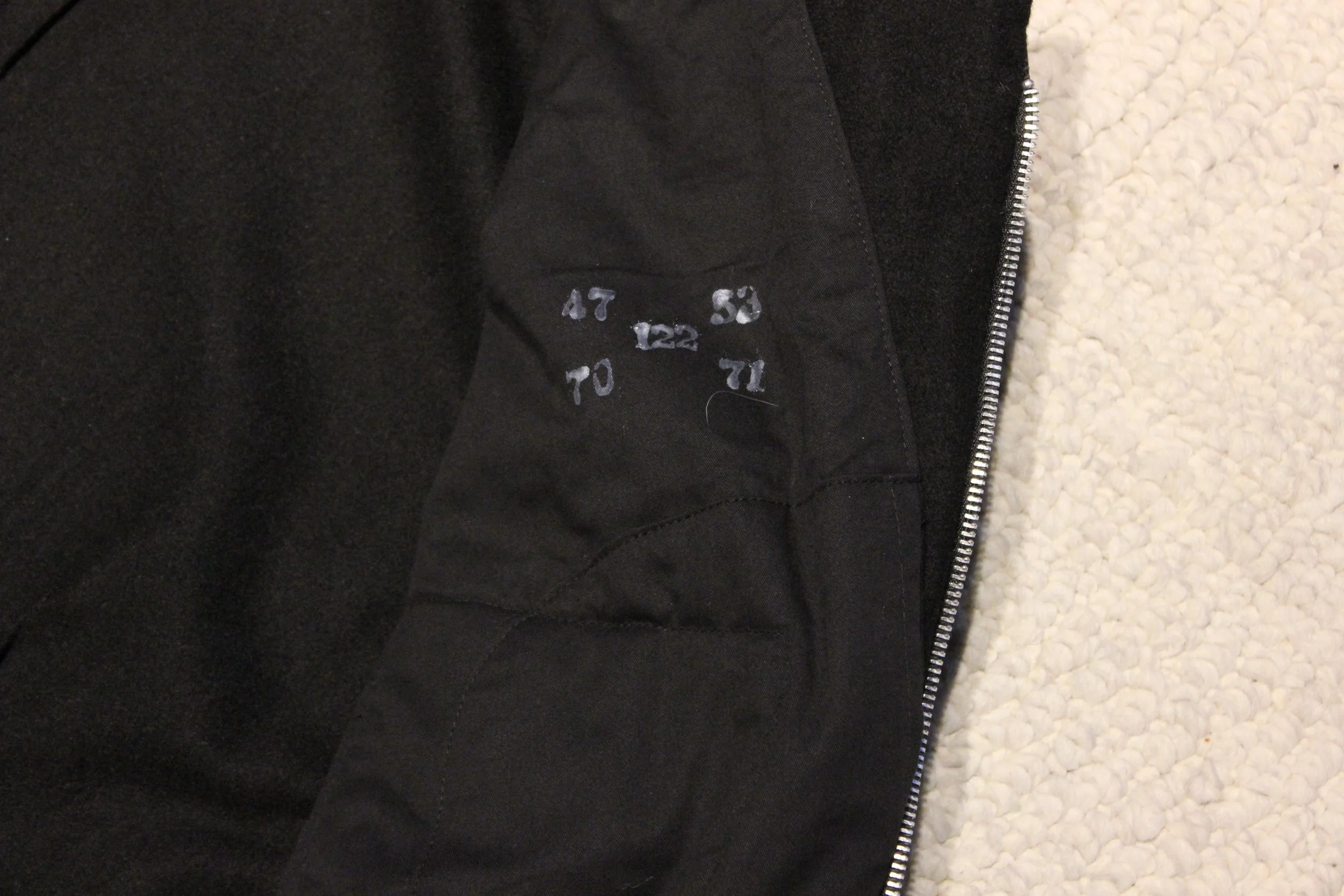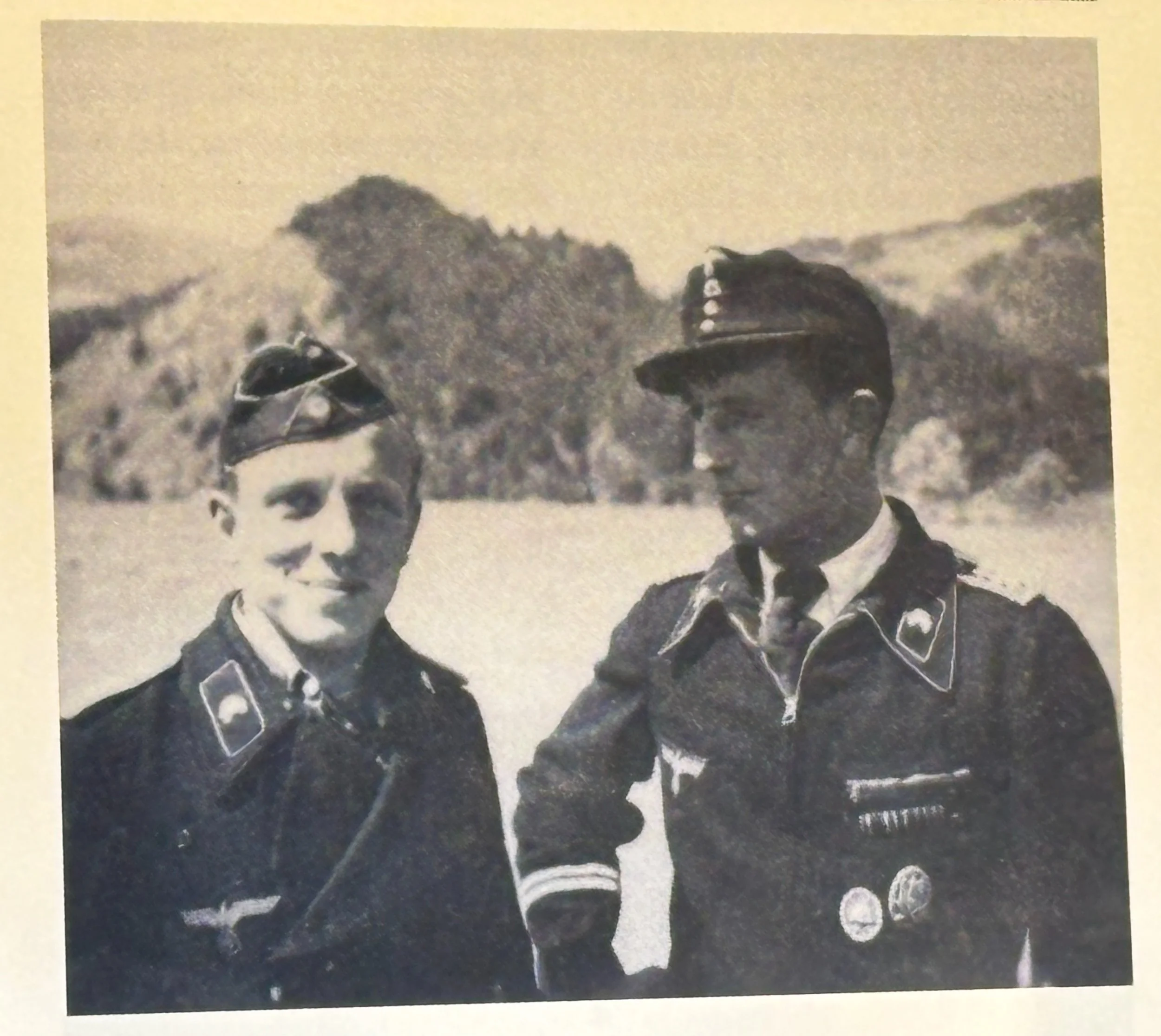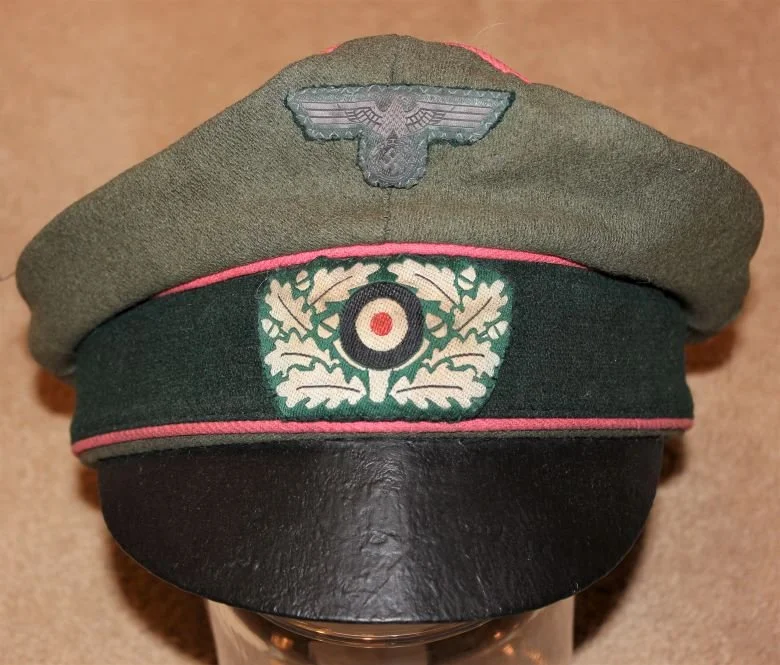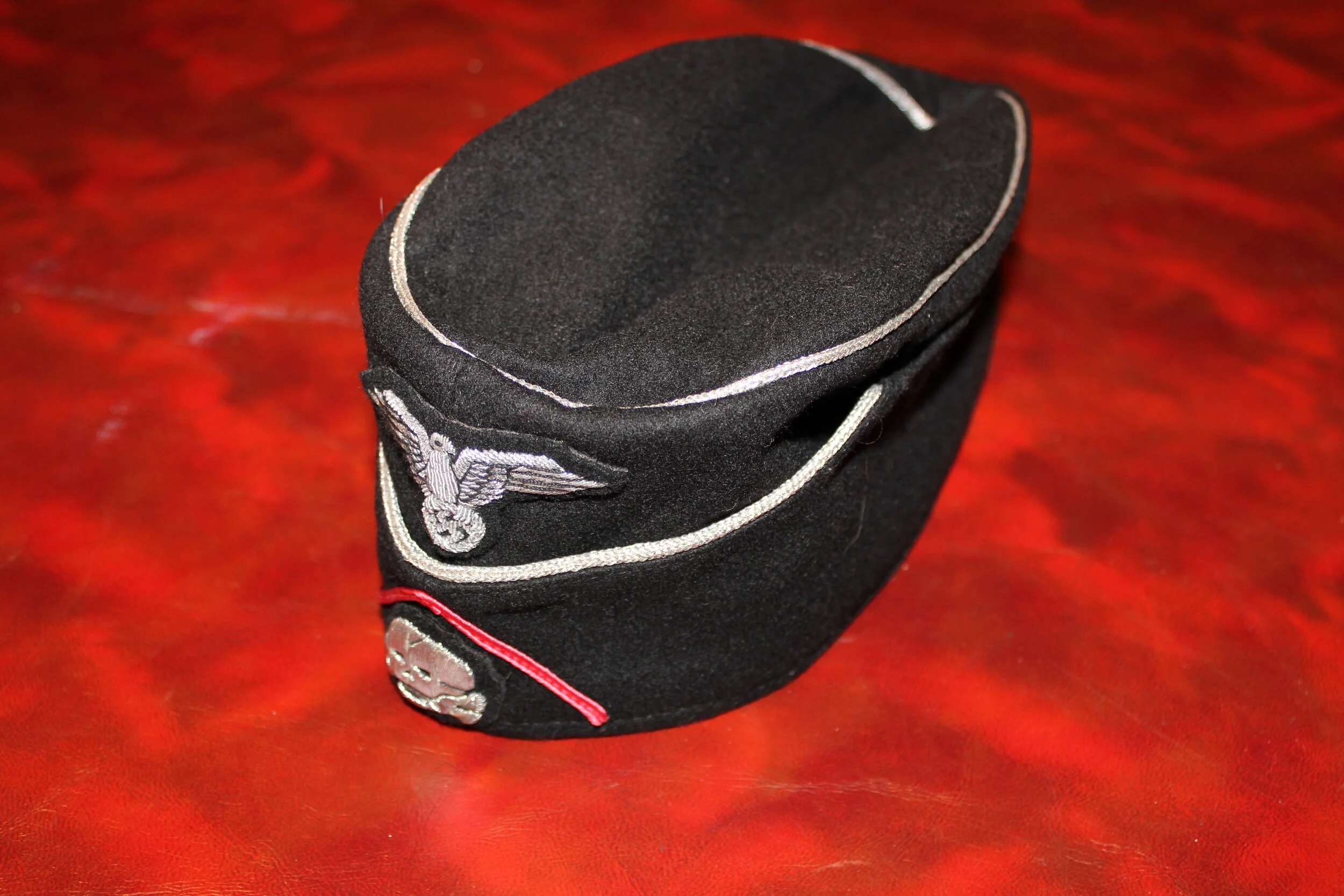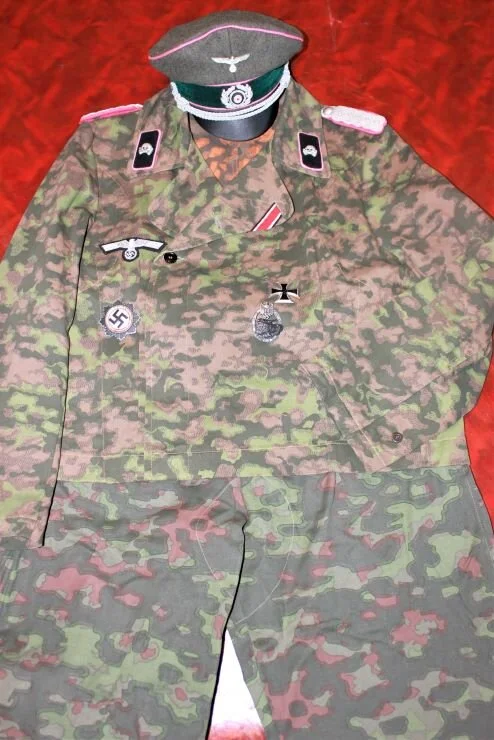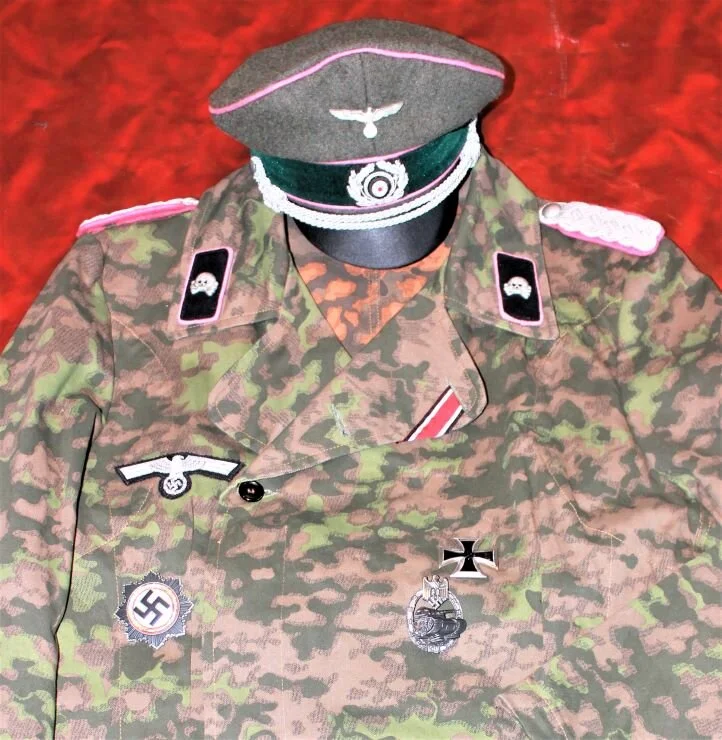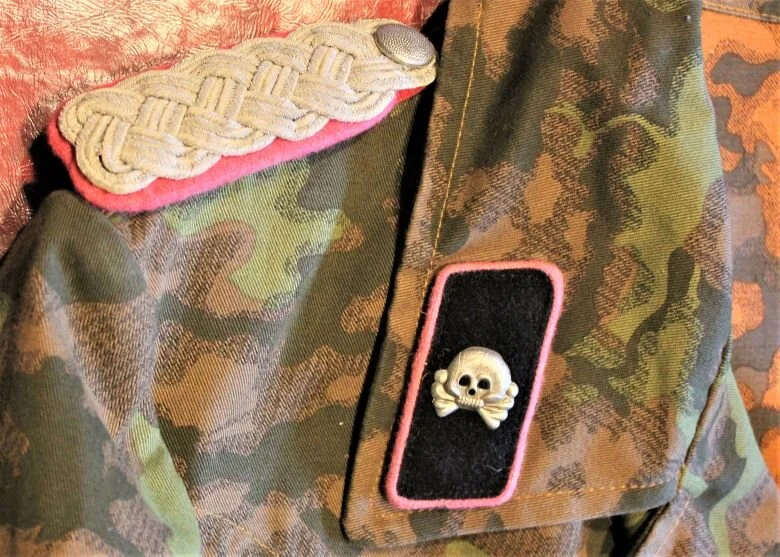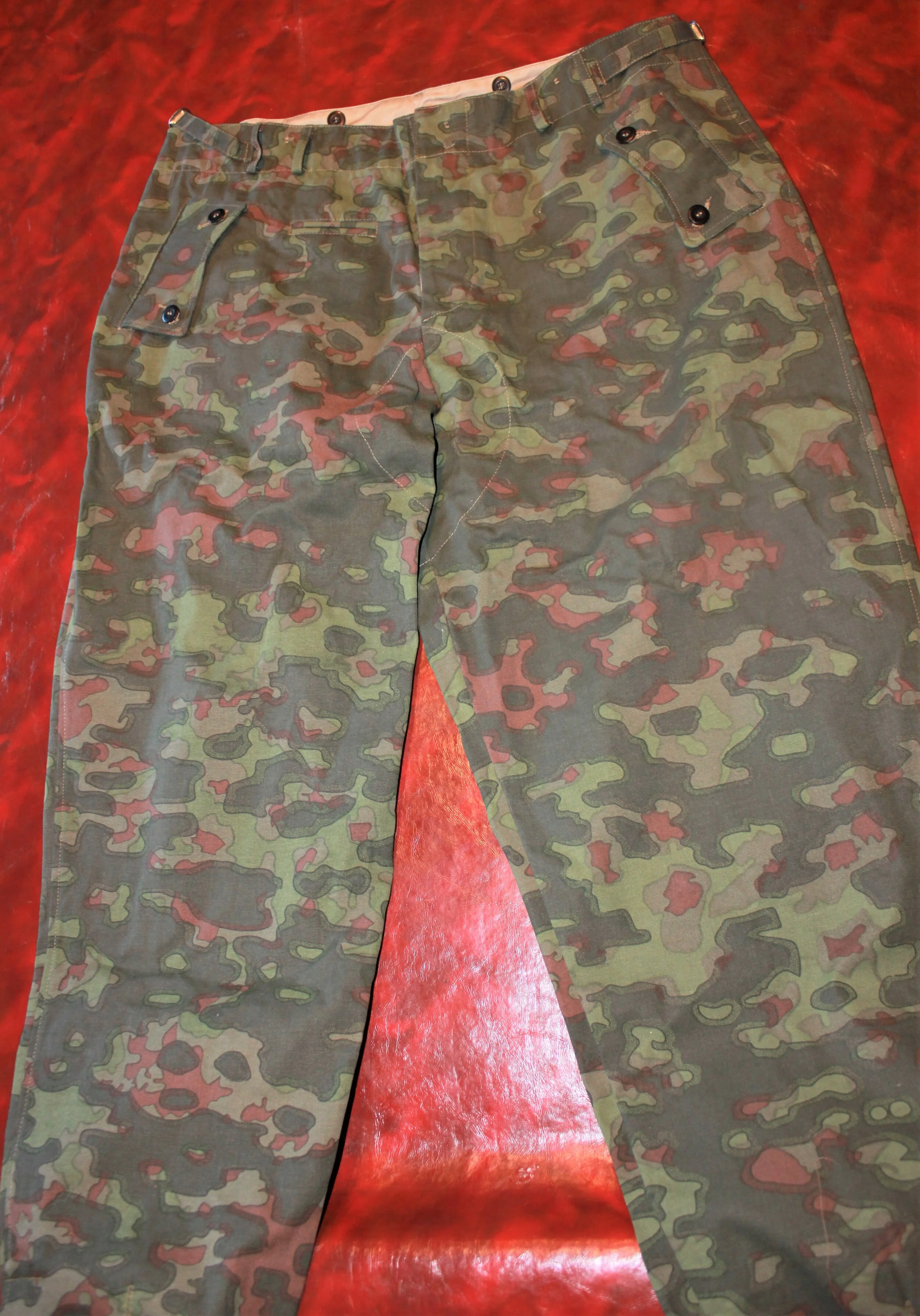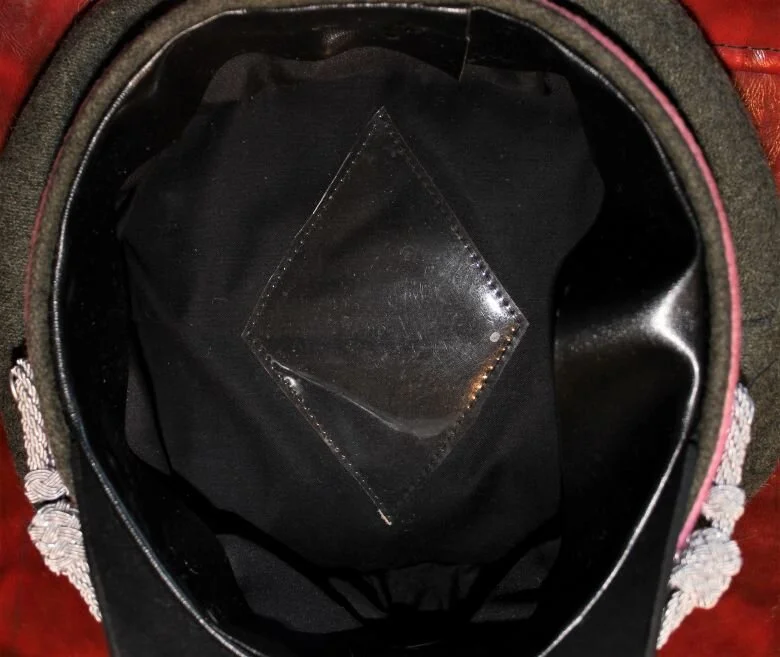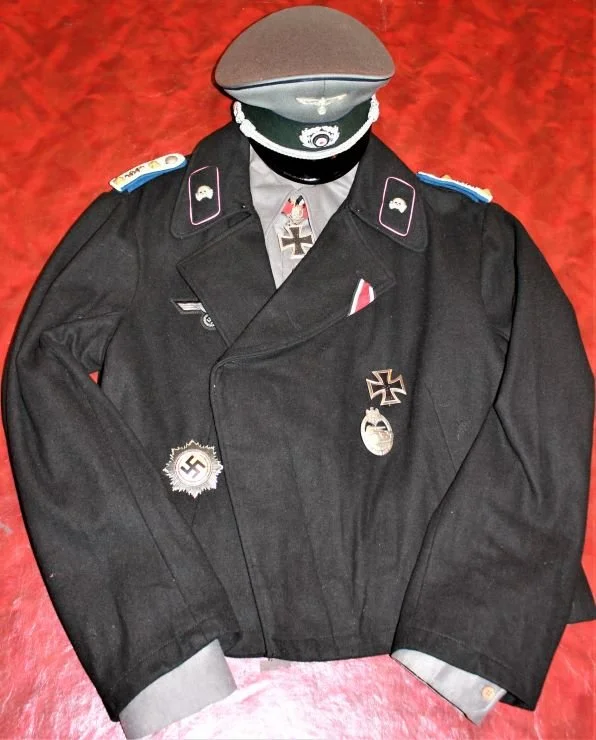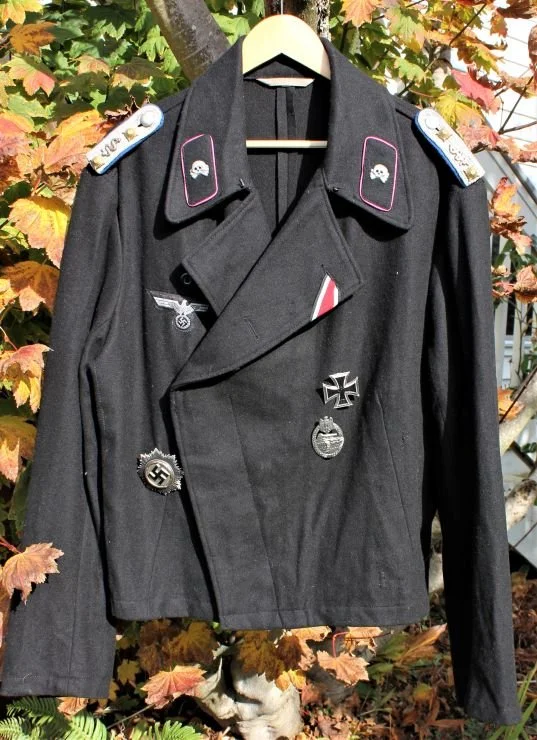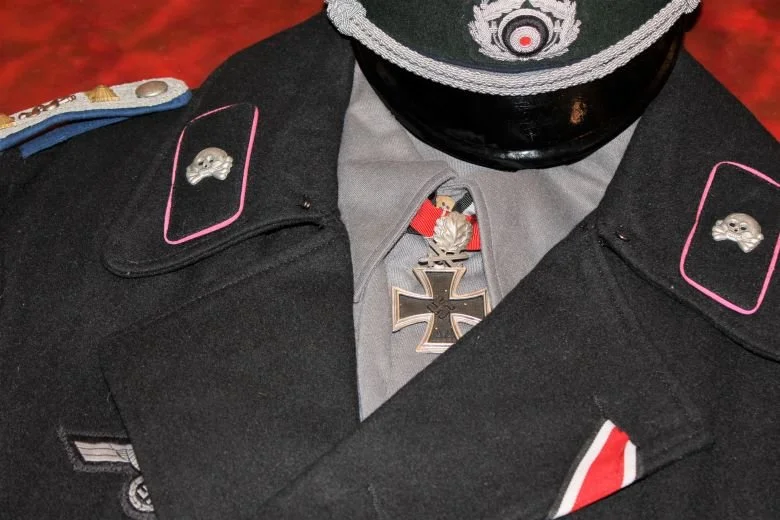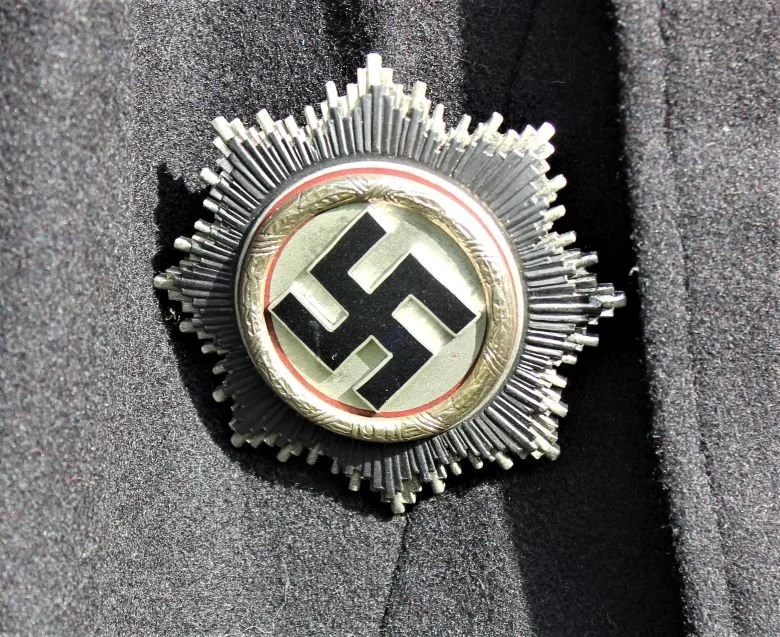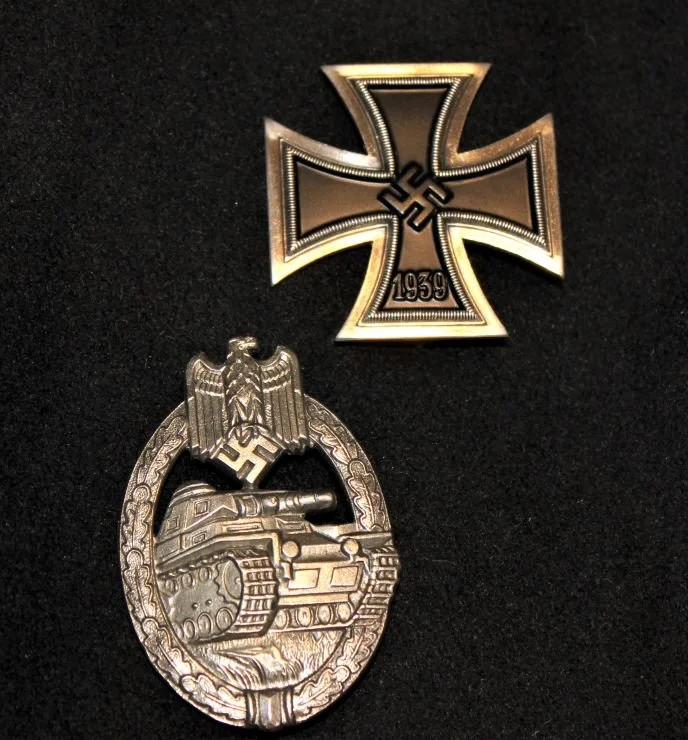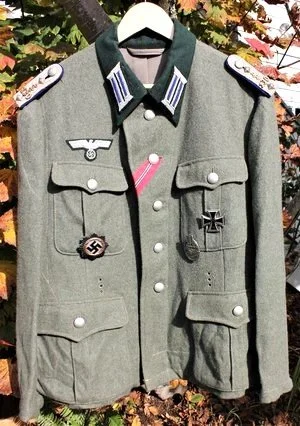Heer Panzer ‘Oddities’
Enlisted, Off-White Panzer-Training Wrap:
This is the general training wrap… if you can say typical, training uniform in the off-white (non-dyed) was used in Germany by the Reichswehr as their work and drill suit; I dont think all that many were issued, as you received the “Work Uniform” as a Recruit, perhaps befor the uniform, they were quite basic in appearance, with no insignia. It was a 2-pocket infantryman’s style jacket for all branches of basic training. They flowed to Panzer Training from there, but the Panzer-Wrap cut pattern has not been widely photographed and is believed to have been used by some of those assigned to the school for vehicle teaching and training of tank crewmen, maybe not so much the trainees.
This represents the typical, basic training type wrap that may have found use with Tank Trainees. There may also have been maintenance and teaching personnel using these.. They may have used specialty groups in conjunction with tank-factory assigned personnel, as more and more pictures are showing up, as a training, utility work uniform, or authoritarians; most have insignia, if any, it was the slip-on shoulder boards.
It may be the uniforms were obtained when a soldier graduated to a particular vehicle or tank assignment, like from Panzer IV at the training school. Some may have been later dyed “Reed-Green” for field use, but by the middle of the War, they were being produced in green dyed material as a lightweight summer uniform by 1943. I have it with a “Black” Panzer crewman cap, but I assume some people may have had the Field Gray ones.
NCOs, Off-White Drill Wrap:
Another example, this one is a bit more elaborate, with extra buttons and a large pocket on the front. This time, the work wrap is that of an NCO, and a bit more dolled up. possibly a teacher or assigned to a tank factory to familiarize tankers with their new vehicles or test the vehicles before sending them off to the front.
The White Cotton and HBY uniforms were a natural color, and the less bleached ones were an off-white. This one has the common “Pocket” on the front, large and hand for a notebook or gloves and the like, many had them later added. Some of these jackets did see front-line use in the summers, and/or over the black wrap in winter.
Unterfeldwebel, Begleitkompanie 16. Pz. :
Little is known about this uniform, yet it is shown in period photographs, as well as similar uniforms. The bone-white HBT uniform was long used as a ‘Work Uniform’ in the German Army. In WWII, the need for a summer / lightweight uniform was a need arose in the Mediterranean and Eastern Front. This same cloth was used, and the material was dyed green. And using the work uniform cut, special wrap cuts went into production. Sometimes the work uniforms and wraps were dyed in the field, all became known as the ‘Reed-Green’ summer uniform, and seems to be very in a very blue-green, and pine green to various shades of added and more medium greens, even Mouse gray, and black that washed out seem to have existed.
The HBT panzer uniform went through a second pattern revision, with added a large pocket on the front of the wrap and the trouser leg, for holding maps and paperwork. Since this was a mid-war modification, it is truly odd to see this uniform in white, which makes it stand apart from others. It was odd to have insignia on these uniforms too, but this one has it, using standard black backer-panzer insignia piped in the rose color for ‘Panzer Waffenfarbe’ applied. It is not meant as a winter uniform (though could have been worn as an over-garment to some) so we figure it was to make the NCO stand out, like a panzer school instructor, NCO training, or specialty training, but it would have been hard to keep it white in a WWII tank, keeping from getting soiled would be a challenge in itself.
The boards show his affiliation with the Begleitkompanie of the 16th Panzer Division. He has been in combat and won the Iron Cross; he was in the Czech Occupation, as there is a ribbon for that too. H is a veteran too, having the “Tankers” version of the Assault Badge and Black Wound Badge.
He wears a standard M-43 Feldgrau Cap, with matching white trousers with zippered pockets in the photo, a gray shirt, and black shoes, just so ya know-I know, its not an exact match to the picture, might have to fix that one day, when I get more money to spend on it.
“NEW” Soldat, 115. Panzer Bataillon, Panzergrenadier Division 15:
In Sicily, July 1943, the new 15. The Panzergrenadier Division was formed from units already on the island. These troops were divided among the divisions’ three Panzergrenadier Regiments. Along with these regiments, 60 tanks of the Panzer Division 15, previously intended for North Africa, were added and designated as 115. Panzer Batailion.
The Allied invasion, Operation Husky, pushed the German forces east across Sicily. Failing to secure the line against the US 1st Infantry Division at Troina on Highway 120, the division continued a fighting retreat. Along with most of the German forces and their equipment, it evacuated from the port of Messina to the Italian mainland.
The Soldat wears the Tropenanzug für das Deutsche Heer or tropical Army uniform fitted with continental-style Panzer insignia. His uniform was issued before deployment south, and the application of the traditional Panzer-style Litzen has been done at the unit level. Privates don’t make such modifications on their own.
If his Bluse had the Afrikakorps Ärmelstreifen previously sewn in place, it was removed following the assignment to Panzergrenadier Division 15. A 115. Pzr.IV and crew. This officer waits while the Kubelwagen’s driver replaces a tire on Highway 120. Vehicles were loaded on a barge for the evacuation across the Straits of Messina to the mainland.
Leutnant 1. Panzer Regiment 1. Panzer-Division Greece 1943:
1. Panzer Division was formed on 15 October 1935 and was headquartered in Weimar as one of three tank divisions created at the time following Germany’s renunciation of the Treaty of Versailles earlier in the year. The treaty forbids the development of tank forces, which Germany had circumvented by secretly developing tanks and operating a covert Panzerschule in the Soviet Union.
In 1938, the division participated in the Anschluss of Austria and the Occupation of the Sudetenland. 1939 brought an action in the occupation of Czechoslovakia and the invasion of Poland. In May 1940, the division was part of the invasion of Luxembourg and Belgium and the Battle of France.
Following the French surrender, the division garrisoned there until September of 1940, when it moved to East Prussia, where the cadre was dispersed from the core of 16. u. 18. Panzer Divisions. Crossing the German-Lithuanian frontier as part of Army Group North, the division was involved in heavy fighting during Operation Barbarossa. By mid-August, it had only 44 of its original 155 tanks. It continued to advance towards Leningrad until early October, when it was transferred to Army Group Center to take part in the advance on Moscow.
The division advanced within 20 miles of Moscow before being forced to retreat during the Soviet counterattack. The division was part of the defense of the Rzhev Salient during early 1942, initially being very short on tanks and fighting predominantly as infantry until being resupplied during Spring. Engaged in the defense of the 9. Army supply lines in the center of the Ost Front, the 1. Panzer suffered heavy casualties from Soviet attacks in the winter of 1942-43.
Transferred to France for rest and refit in January 1943, the division spent a month before being mobilized and sent to Greece as part of reinforcements to oppose anticipated Allied landings. With the landings coming in Sicily, not Greece, the division took part in the disarmament of Italian forces after their defection from the Axis in September 1943.
The division was brought up to strength and upgraded with Panther and Tiger tanks returning to the Ost Front in the late fall of 1943. The standard uniform in Greece was the Tropical Bluse worn with continental insignia in a photo from 1. Panzer Regiment’s deployment in Greece. After the disarmament of the Italian forces, their duty was enjoyable.
This uniform depicts one of these rare tropical uniforms in use with the 1st Panzer Group in Greece. The addition of standard continental insignia to the uniform became the norm, as clearly shown by the period photos. The Leutnant has added officer quality buttons, making use of the S-clip retainers standard to this style of Bluse. The Leutnant is serving in Greece with the 1 Panzer Division.
The “1” on the rose-piped shoulder insignia indicated his regimental affiliation. His awards indicate service in Russia, with the Leutnant perhaps having rejoined his unit after attending Junckerschule following promotion from the ranks of seasoned NCOs. He has also earned the Eisernes Kreuz II. Klasse and Panzerkampf-abzeichen in Silber.
This Bluse possibly saw service in the following summer in Russia or perhaps was shipped home or left behind as summer turned to fall in Greece. The Bluse was worn with matching tropical trousers and boots, some have mixed Panzer uniform items, as shown in the photos with an issue light shirt and black tie, with a Feldmütze für Offizier. While onboard his Panzer, he wears the standard double-prong buckle belt with a side arm, perhaps a map case.
Note: It has been said the uniform was “Tan”, it was not, it was olive, I’ve seen more brownish, and an unpopular greenish (called Russian Green), and these two fall somewhere in between those. Again, I work within a budget as well.
Panzerschütz, 1./Panzer-Brigade 101:
Panzer-Brigade 101 was first established in early June 1941 by Wehrkreis XII in France at AOK 1. For this purpose, the task force for the formation of captured tank units, established in mid-May 1941, was used. On 21 September 1941, the already established elements of Panzer-Brigade 101 formed the staff of the 23. Panzer-Division and Panzer-Brigade 101 were disbanded. On 11. In July 1944, an OKH order was issued for the re-establishment of ten Panzer brigades. As part of this, Panzer-Brigade 101 was reestablished and was to be combat-ready by mid-August 1944 at the latest.
In October 1944, Panzer-Brigade 101 was used in Arys to replenish the 20. Panzer Division, which had been defeated in Romania. The staff of the former Panzer-Brigade 101 was incorporated into the staff of Panzer-Regiment 21. Wearing the standard Panzer uniform, the Schütz stands out as do all Panzer-Brigade 101 troops with the use of the traditional, unique Totenkopf reserved for Infanterie-Regiment 17.
Multiple photos show this to be the brigade-wide norm to include commander Ritterkreuzträger Major Friedrich-Wilhelm Breidenbach. The why of this use has not been found in the documentation.
Hauptmann, Deutschekreuz Winner Heer, Zippered Wrap:
*This man has been identified, but I misplaced the information. This is a rare, interesting, and unique Panzer jacket; if you look closely, it’s entirely custom. I have only seen two of these in use; the other was a Leutnant, and it belonged to Hans Babo von Rohr, a Knight’s Cross Winner as well. He had served with the 25th Panzer Regiment “Rothernburg”. The Leutnant was killed in action on 14 February 1946, a month and a half before the war ended in the fighting at Konitz. He was credited with knocking out 58 enemy tanks. He also had the “Individual Tank Killer” patches on the right sleeve, but he had 3 of them rather than 2. and does not have pink piping around the collar. However, my uniform is of a different person, with the German Cross in Gold on the uniform; however, he may have very well been from the same unit. I have now found Oberfeldwebel Herbert Elsner, who was in the 23rd Panzer Regiment. (I don't have a picture of him)., It’s interesting he, too, has the German Cross in Gold! 50-engagement Panzer Assault Badge. He also wore on his uniform the Iron Cross 1st Class, a Hitler Youth diamond, and a Prague ribbon. in the book I found it in, the was another picture of a comrade, with a similar jacket but only 1/2 length zipper on the fron, he was the unit’s Speiss, but this one is a later stock. So it appears at least 2-3 tankers of the 23rd regiment had this kind of modified panzer wrap.
Sometimes a Hero has no name, or the distinguished names are lost to time. That seems to be the case with this Panzer Hauptmann. Decorated with the **German Cross in Gold, *Panzer Assault Badge for 75 Battles, Two Tank Destruction Badges, the Iron Cross 1st Class, (2nd class not used here), and the Wound Badge in Silver, this young officer is the epitome of the German Combat Officer of the War.
In the photograph (probably a Battalion or Regimental photograph), he is seen in a posed but informational group setting (probably taken at a time of Rest and Recovery) before they return to combat.
We, of course, can speculate, but it is clear that he has the positional power to create and wear a modified combat uniform. A standard Panzer-Wrap has been seriously modified into a far more practical and functional zip-up jacket. He has the typical shirt and tie underneath it. A large part of the front has been just removed to provide the two panels that now zip together. Out of the saved material, he has applied two zipped closed patch pockets. Adding rose piping to the collar indicates more custom work, which reflects the earlier uniform look.
Note: The Combat Assault Badge with 75 on it dates back to 1943, so we can date the jacket to some time after that. Speculating that this officer likely wore the practical M43 cap. Not seeing his trousers in the picture, being a sharp dresser, I guess the panzer-black ones would be in line, tucked into panzer ‘Shor’ Boots. No belt is visible either, and he appears to be a pretty ‘lean’ soldier.
* The German Cross in Gold was awarded for Combat Service, recognized for actions above the Iron Cross I, but less than the Knight’s Cross.
*Did he survive the war? Did he earn the Knight’s Cross by the war’s end? I have found no more information. In time, more will possibly come up, but until then, this is a good representation of what was sometimes done to the uniforms if allowed to.
*Also, I thought I had identified this uniform’s wearer, but maybe not; I am still not positive. I have found in the Book “The Panzer Soldiers” a Near identical zip-front jacket, worn by Oberfeldwebel Herbert Eisner, from Panzer Regiment 23. he too has the German Cross in Gold!
*And on the uniform wore the Praug Ribbon and a short bar, above the Hitler Youth diamond-pin, and the Iron Cross 1st class and that’s it!, but rather the two zip-breast-pockets, he had two slash pockets near the belt line and different ranking shoulder boards, he wore a black M43 style cap with a metal eagle on it, He may have been an officer candidate though the book by Wade Krawczyk says that’s not the case and implies maybe a unit identification band, he is seen in an early model of the Panther Mk V Tank (Panzer). So, make of that what you will, he may have just had the same idea to make one of his panzer wraps like this.
I guess I need to find the Captains of the 23rd Pz. RGT and 25th.
Note: The period black and white photos are off the internet, this is the fellow we have represented, the First picture who the uniform is based on but I don’t know wh it was, the second is Hans Babo von Rohr, I found in the book “Field Uniforms of German Army Panzer Forces in World War 2” (Pruett and Edwards). The Third is from the book “The Panzer Soldier” (by Wade Krawczyk). I give all credit to the copywriter and the books.
Oberleutnant, 22./ Panzer. Regiment. July 1944, custom jacket from Fallschirmjäger smock:
The Panzer Regiment of the 21st Panzer Division, the 22nd had ceased to exist following the battle of the Kasserine Pass in Africa It was Reconstituted in France in June 1943, where it remained for rehabilitation and garrison duty until the Allied landings in Normandy and was the only Panzer division to engage the invasion on 6 June From the Ashes The division was formed from the elements of the newly created Schnelle Division West, a concept for a highly mobile type of formation that was intended to be able to cover a great deal of territory to reach any point of invasion.
German industry could not provide the vehicles for the unit, Schnelle Brigade West. Largely fitted out with captured French half-tracks and light tanks that had been armored and up-gunned by a mechanical engineer by the name of Alfred Becker. Working at a conversion facility, Baukommando Becker, near Paris, Becker provided the unit with most of its transport and all of its assault guns.
On June 17, 1943, Schnelle Brigade West was upgraded to Schnelle Division West, and on June 27, 1943, was assigned the name 21st Panzer Division. Major Becker was assigned the command of the division's anti-tank battalion, Panzerjäger-Abteilung 200. The division was under the command of Rommel, who was responsible for German forces on the center Western Front.
Invasion! Rommel had been away from the front during the first days of the invasion on leave to visit his family; he re-assumed command on 9 June. The division was grouped with two SS units under the command of SS-Obergruppenführer Sepp Dietrich, which were to push northwest to retake Bayeux but this plan was abandoned when the divisional staff was killed in a bombing raid. The division continued to fight as part of the front throughout June and July.
Between 6 June and 8 July, the 21st Panzer reported the loss of 54 Panzer IVs, with 17 Panzer Vs. The last major action the 21st Panzer took part in during Operation Bluecoat was holding against the attack of the Guards Armored Division on August 1st. What remained of the division was mostly destroyed in the Falaise Pocket; a small part managed to escape across the Seine River at Rouen and merged with the 16th Luftwaffe Feld Division.
The 21st Panzer was not committed to offensive actions in Operation Wacht am Rhein, assigned to provide cover to the flank of the attack. On 29 December, 21st Panzer reported the following strength: 72 PzKpfw IVs, 38 PzKpfw Vs, and 8 Flakpanzer IVs. Sent to the Ost Front in late January, the division surrendered to the Red Army on 29 April 1945. The Oberleutnant is perhaps following a division directive to make use of camouflage garments. As a combat leader, he may find himself outside his command Panzer subject to enemy observation and fire.
In France, recovering from destruction in Africa, the Panzer Regiment officers may well have obtained Fallschirmjäger jump smocks and had local tailors make them into shortened over-jackets. He has applied standard Panzer insignia to the collar and shoulders of the jacket along with an officer-quality BEVO national eagle. Along with the overcoat, the Oberleutnant will probably wear his standard Panzer uniform with ankle boots.
Photos show that at this point in the war, headgear use was varied, but he will probably make use of the Eineheitsfeldmütz für Offizier Model 43 or the classic, pre-war Feldmütz. Also, as more pictures show up of the actual uniform we’ve tried to depict, while we knew the Regiment, it appears the 22 was not on the shoulder boards actully… it figures, thought I’d add this in here before I’m called out on it.
Heer Panzer Hauptmann, in Waffen-SS, 44 Dot pattern Camouflage Wrap:
Some casual-looking photos, some perhaps from a command group, show some diversity in this unit, and at this point in the war of this unit. I’m talking about “Heer” Wehrmacht troops in Waffen-SS issue uniform stock, only seen with SS Troops, while the Waffen-SS at the time wore Wehrmacht camouflage, and the Kriegsmarine and Luftwaffe used the same as the Heer.
A survey of the awards won in the group indicates an experienced bunch. All of them are trained and combat-proven; this may have been at a place of rest and refit before heading off to combat once again. It’s some kind of meeting.
Our focus is on the officer fourth from the left, who is wearing a standard SS-panzer wrap known as the 44 Dot. This places the photo to probably the winter of 1944-45. The officer has added his Heer (Army) insignia from a standard Heer panzer uniform, like the officer to his left. He also appears to be wearing HBT-style trousers, identifiable by the large pocket on his leg. Like most of the others, he wears matching-style boots.
Were these officers on the way to the Ardennes!? Did you have any service? Perhaps later, more information will be added, but for now, we see a unique modification of a uniform from one branch of the Wehrmacht used with another. It is quite possible they were working alongside a large group of SS Troops when they received new uniforms, and just grabbed them as needed because that’s all that was available. I have seen pictures of custom M43 and M44 pattern uniforms as well.
Originally, there were different, fuzzier pictures where I contemplated the subject, and they were all in different patterns and different model uniform in the 44DOT pattern of camouflage, even though more pictures of the use with the Heer Wehrmacht. It wasn’t done very often, of the thousands of soldiers, this is my depiction of one of these odd uniforms. The example is not a panzer-wrap, but a tight collared 4 pocket in use, but the National Eagle does appear to be black backed, topped with leutnant shoulderboards, and officers ‘ crushed cap.
Heer / Wehrmacht, Panzer Major in SS-Blurred-Edge Camouflage Conversion:
A young Heer Panzer major on leave near the war’s conclusion wears a Waffen-SS camouflage Panzer Jacket and trousers. Both pieces of the uniform are produced in the Normandie or Blurred Edge …or Leaf Pattern Camouflage pattern. This print was utilized in the production of a wide variety of standard SS garments. This being the case, a well-placed Army officer could, if he wished, obtain a set from a Waffen-SS contact.
Army production of camouflage uniforms was restricted to the Zeltbahn, Stahlhelmbezuge, Turnjacken, and Winterbekleidung. This meant that Heer soldiers wanting camouflage uniforms had to have them tailored-made or utilize issued items from the SS and Luftwaffe.
It is easy to see how a young officer would be attracted to the SS-Panzer Uniform for its practical applications. What is more difficult is that he would be allowed to wear it anywhere except at home, on leave, or at the front, where such issues were minimal and ranked lower on the scales of importance.
Looking at the photographs, it was taken on a lake or river, perhaps by a waterside dock or troop barge. The uniform appears to be new, or at least pressed.
The suede gloves and striped officers indicate he’s in a walking-out posture. Completing this uniform, the officer wears marching boots, along with the issue shirt and tie.
Flexing easily at the visor, we can see the cap is a “Feldmutz” fur Offizier or Crusher Cap that has had an Officer’s type chin-chord added to it. The Waffenfarben would be Rose, which would match his collar and shoulder insignia, which have been added along with the “Heer” National Eagle on the Right Breast (Where the SS has used Heer-Eagles but on the Left Sleeve).
This, by regulation, was forbidden on camouflaged uniforms until the “Special Sleeve Rank” using Green or Yellow sets of bar and Oak-Leaves, for these uniforms were introduced in the final year of the war, and used by the Heer and the Waffen-SS. But the practice at this point in the war was also being overlooked and just ignored.
There is just one decoration in the photo, the Eisernes Kreuz II. Klasse ribbon on his lapel. The lack of decorations for a Major at this point in the war is something of an oddity in itself. One has to wonder if there are over-hitch loops for the commonly worn by this point in one’s service, like the Eisernes Kreuz Klasse I, Panzerkampfabzeichen, and Deutsches Kreuz, possibly, for use at a later time?
The last picture shows the first period picture, which shows a possible similar uniform; the collar tabs have been applied, but the Totenkopf skulls are neither pointing forward aor sideways, they are angled, as paralelle with the ground.
“New Pictures” Ritterkreuzträger Adelbert Schulz, Commander, 25 Panzer Regiment:
Generalmajor (Major-General) and division commander in the German Army during World War II. He was one of 27 people to be awarded the Knight’s Cross of the Iron Cross with Oak Leaves, Swords, and Diamonds, and he was one of the youngest Generals. He took part in the occupations of Austria and the Sudetenland. During the Western Campaign, in 1940 was promoted to Captain. He participated in the invasion of Belgium and attacks on French and British positions, and he assisted in the breakthrough to Cherbourg, serving under General Rommel. On 29 September 1940, he received the Knight’s Cross of the Iron Cross. As part of the Army Group Center, in Klin, Shulz attacked a Soviet force eight times larger than his own. Despite being outnumbered, he covered the retreat of German troops and the evacuation of the field hospital, with more than 4000 wounded. For these actions, he was awarded the Oak Leaves to his Knight’s Cross on 31 December 1941. On 6 August 1943, he received the Swords to the Knight’s Cross and, with that, a promotion to Colonel.
The 7th Panzer Division, subordinated to the 4th Panzer Army under the Command of Hermann Hoth, started a counteroffensive against the recently evacuated city of Kharkov on 11 March 1943. Albert Shultz, who had just recently before, been put in command of the Panzer-Regiment 25, led his Kampfgruppe in one of the most successful engagements of the “Gespensterdivision” (Ghost Division). His soldiers destroyed more than 100 enemy tanks and artillery positions during the annihilation of the Red Army’s 3rd Tank Army. On 14 December, Schulz received a radio message that he would receive the Diamonds to Ritterkreuz and was ordered to report to the Führer’s headquarters. Schultz refused to go because he was too busy fighting on the Eastern Front and had no time to receive it; the matter at hand was too important. The Honor was eventually awarded to him on 9 January 1944, and he was promoted to Major General and made division commander in charge of Rommel’s former division.
Generalmajor Adelbert Schultz led tanks of the 7th Panzer Division in an attack against the enemy positions at Shepetivka on 28 January 1944. Standing in the open hatch of his tank, Shultz was hit by artillery shrapnel in the head. Shultz succumbed to the injuries the same day, even though he had been immediately evacuated to a field hospital. His death was announced on 30 January 1944 in the Wehrmacht.
In the photos, Schultz is shown before the massive battle at Kursk in 1943. He is wearing a Waffen-SS four-pocket camouflage tunic made of plane-tree over print fabric, with green blotches or spring colors on one side and autumn brown shades on the other. The Heer-Colonel’s uniform shows shoulder insignia with the regimental number applied to them. A “Heer” style National Eagle has been added. Shulz wears no other decorations other than the Knight’s Cross. He was a modest man, apparently, and wise enough not to have a flashy uniform on the battlefield.
He wears standard Panzer trousers, with the “Officers” style Feldmutz worn, the shirt issued, and boots. His other gear is probably in the command vehicle. I shot the uniform originally with the camouflaged one because I don’t think I could find the black Panzer officer cap; eventually, it showed up and was added here.
I must have heard a thousand time the “Heer” Wehrmact never wore SS uniforms- they were far to dissiplended, and these are not real, but, one in the field uses whats available various branches, have their official patterns, but time and again, I have found more odd, and un-official uniforms, over the years. It just happens sometimes.
*Merkel, Abteilungsarzt, I. Abteilung, Panzer-Regiment 35, 4. Panzer-Division
The man who would become known as the Panzer Doctor! April 6th, 1913 (Oppeln/Silesia, Germany). He had been a Major of the reserves in WWII. He earned the title when, on November 19, 1943, the commander of I./Panzer-Regiment 35 requested that Dr. Schulz-Merkel take over the Abteilung because he had become very ill. Schulz-Merkel led the Abteilung through the battle of Karowotitschi, where it destroyed 15-20 Soviet tanks and numerous infantry forces. Pushing on, they broke a Soviet encirclement ring, allowing the trapped German division inside to escape. Schulz-Merkel, for his leadership through the battles that was completely outside his field of operations, was awarded the Ritterkreuz des Eisernen Kreuzes on December 23rd, 1943. He served in the War, passing away, September 2nd, 2000 (Marktoberdorf/Bavaria, Germany).
*Shit, I just deleted the original story.













































